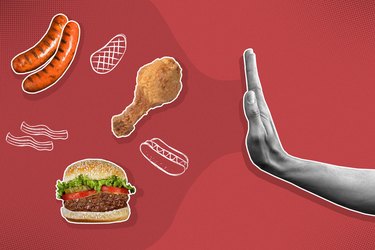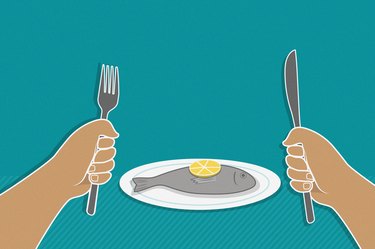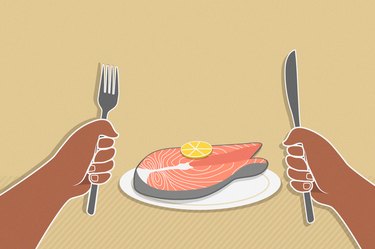
If you're a meat lover, you may cringe at the thought of giving up your favorite dish. While there are certainly benefits of a plant-based diet (which can include animal products but is centered around fruits, vegetables, nuts, seeds and legumes) you can still eat meat and maintain a healthy lifestyle.
The main things to consider are the types of meat you eat and how much you eat.
Video of the Day
Video of the Day
"You can eat meat every day and live a healthy lifestyle," says Mia Syn, RD. "Meat is a source of high-quality, complete protein, but you want to be mindful of what type you are consuming and how often."
Of course, you may have other reasons for eating less meat, such as wanting to put less strain on natural resources, protecting the welfare of animals, or saving money. But in terms of nutrition alone, here's what you can expect (both the good and the bad!) when you eat meat every day.
The Benefits of Meat
Meat has nutritional benefits that can help you live a healthy lifestyle. Here are some of the main perks you'll get when you eat healthy sources of meat in moderation.
1. It's a Good Source of Lean Protein
Meat is known for being high in satiating protein. Protein plays several important roles in your body. It's involved in the production of muscle, structural tissues, hormones, transport molecules and antibodies, per the Ohio State University Wexner Medical Center.
It also provides you with energy and essential amino acids. Getting your protein from animal products can be beneficial as animal proteins are complete proteins, meaning they contain all nine essential amino acids.
But, not all sources of animal protein are healthy choices. It's important to choose types of meat that provide protein without too many unhealthy nutrients — like saturated fat or sodium. To get your protein from animal sources, Ohio State University recommends looking for leaner, unprocessed sources such as:
- White-meat poultry, like chicken or turkey breasts
- Pork tenderloin
- Lean or extra-lean cuts of beef such as sirloin or round cuts, or ground beef that is at least 93 percent lean
"If you are consuming lean meat and poultry prepared with no or little added sugar, saturated fat and sodium within the portions recommended to meet your nutritional needs, you are likely to experience positive effects like greater satiety, easier weight management and better energy," Syn says.
Protein digests slowly in your stomach, per the American Heart Association (AHA). This helps you feel more full for longer — even if you're not eating more calories.
"A little bit of protein at each meal is going to help you feel more satiated," says Joan Salge Blake, RDN, a nutrition professor at Boston University and host of the nutrition, health and wellness podcast Spot On! "It will help you watch your weight and feel fuller for fewer calories, which is advantageous."
Of course, you can get protein from various sources (including plant-based foods) to serve this purpose, but lean meats can be a great option.
2. It’s a Good Source of Iron
"In addition to providing high-quality protein, meat provides certain key nutrients that are hard to get elsewhere," Syn says. "For example, heme iron found in animal foods is more readily absorbed by the body than non-heme iron found in plant source foods like beans and vegetables."
Meat, poultry and seafood have both heme and non-heme iron, per the National Institutes of Health (NIH). Your body needs iron for growth and development as well as to create hemoglobin and myoglobin, proteins that transport oxygen throughout your muscles.
Too little iron can cause iron-deficiency anemia, with symptoms like weakness, tiredness, lack of energy, gastrointestinal upset and problems with concentration or memory. People with iron deficiency anemia also have a more difficult time fighting off germs and infections, per the NIH.
"A lot of people, especially women, are short on iron in their diet," Dr. Salge Blake says.
3. It’s a Good Source of B Vitamins
Lean meats can help you fit in B vitamins, which support your metabolism and help your body produce energy, per the Academy of Nutrition and Dietetics.
In particular, vitamin B12 is naturally found in animal foods like lean meats. It is needed to form red blood cells and DNA, per the Harvard T.H. Chan School of Public Health. It also plays an important role in forming red blood cells and DNA.
Among vegetarians and vegans, 62 percent of pregnant people, up to nearly 86 percent of children, up to 41 percent of adolescents and up to 90 percent of older adults had vitamin B12 deficiency rates in a February 2013 study in Nutrition Reviews. Vegetarians and vegans should take preventative steps to avoid deficiency, such as regularly taking a B12 supplement.
The Risks of Eating Meat
Of course, regularly eating meat can also have unwanted side effects — especially if you choose unhealthy types. Here's what to watch out for if you're eating meat daily.
1. It Can Be High in Saturated Fat
Certain types of meat have high amounts of saturated fat, which is unhealthy if you eat it in excess, per the U.S. National Library of Medicine (NLM).
Too much saturated fat can raise your LDL (bad) cholesterol and increase your risk for heart disease or stroke. It can also cause weight gain — fat contains 9 calories per gram, which is more than double the amount in carbohydrates and protein.
Limit saturated fat to no more than 10 percent of your daily calories, per the Dietary Guidelines for Americans. That means if you're eating 2,000 calories per day, you should have no more than 200 calories (22 grams) of saturated fat.
To further reduce your heart disease risk, limit saturated fats to less than 7 percent of your daily calories — which would be just 140 calories (16 grams) from saturated fat, per the NLM. To put that in perspective, three slices of cooked bacon contain nearly 5 grams of saturated fat.
2. Red and Processed Meats Are Linked to Disease
Processed meat refers to that which has been treated for preservation or flavor, such as through salting, curing, smoking and fermenting, per the American Cancer Society.
This type of meat is classified as a carcinogen, or something that causes cancer, by the International Agency for Research on Cancer (part of the World Health Organization). The agency classifies red meat as a probable carcinogen, or something that probably causes cancer.
Experts have debated this topic and, ultimately, more research is needed, but, it seems as though moderation is the key. People who ate red or processed meat four or more times weekly had a 20 percent higher risk of colon cancer than those who ate it less than twice a week in an April 2019 study in the International Journal of Epidemiology.
For each daily 25-gram serving of processed meat, equal to about a slice of ham, colon cancer risk increased by 19 percent. For each daily 50-gram serving of red meat, about the size of a hot dog, colon cancer risk increased by 18 percent.
Red meat is also linked with high cholesterol, which in turn can raise your risk for strokes, heart disease and heart attacks, per the Cleveland Clinic.
Tip
Try to limit your red meat to just one to two servings per week — which is 6 ounces or less. If you have heart disease or high cholesterol, should limit it to 3 ounces or less per week. The healthiest types of red meat are lean types of pork, steak and ground meat.
3. It Can Be High in Sodium
Smoked, cured, salted or canned meat — including bacon, cold cuts, ham, sausage and frankfurters — are considered high-sodium foods, per UCSF Health. And while your body only needs ¼ teaspoon of sodium per day, the average American eats 20 times that.
Diets high in sodium are linked to a greater risk of developing high blood pressure, which is a leading cause of stroke and heart disease, per the U.S. Food & Drug Administration. Deli meat sandwiches, poultry and burgers are main sources of sodium in the American diet.
The Daily Value (DV) for sodium is less than 2,300 milligrams per day. As a general guide, 5 percent DV or less of sodium per serving is considered low while 20 percent DV or more is considered high.
Meanwhile, an ideal limit is no more than 1,500 milligrams of sodium per day for most adults, especially those who have high blood pressure, per the AHA. Reducing your sodium intake by just 1,000 milligrams per day can improve blood pressure and heart health.
To put that in perspective, just one link of sweet Italian sausage contains 479 milligrams of sodium — or 20 percent of the DV.
How to Eat Meat Every Day the Healthy Way
In addition to limiting your red meat and processed meat — and watching the sodium levels of the meats you choose — a few simple strategies can help you include meat and poultry as part of a healthy diet, per the Mayo Clinic:
- Look for lean cuts of meat. Opt for round, chuck, sirloin and tenderloin for beef. Choose tenderloin, loin chop and leg for lean pork or lamb.
- Skip the skin. For lean poultry, choose white meat from the breast with no skin. If you like dark meat, remove the skin.
- Double-check percentages. Look for the ground beef with the highest percentage of lean meat (90 percent or higher). Keep in mind that ground poultry can be as high in fat as ground beef because it often includes skin and dark meat, so make sure you choose at least 90 percent lean ground chicken or turkey.
- Watch the labels: Opt for beef that is labeled "Choice" or "Select" instead of "Prime," which is typically higher in fat.
- Trim the fat: In addition to buying lean cuts, cut off any visible or solid fat from meat before cooking it.
Tip
The way you cook meat and poultry is also important. Use low-fat cooking methods like broiling, grilling, roasting, sauteing and baking, per the Mayo Clinic.
Because a lot of fat can melt away during cooking, put meat or poultry on a rack in a baking pan when you cook it in the oven so the fat will drip away. Add more flavor with marinades.
What’s a Serving Size?
If you do choose to eat meat, it's best to aim for no more than 3 ounces per meal (about the size of a deck of cards) — and ideally no more than a couple of times a week, per the Mayo Clinic.
Keep in mind that 3 ounces only equals half of a boneless, skinless chicken breast, one skinless chicken leg with thigh or two thin slices of lean roast beef.
You can imagine the size of any of these items to visualize a 3-ounce serving of meat, per the AHA:
- A dollar bill
- A deck of cards
- A checkbook
- A mini pack of tissues
- A box of eight crayons
- An outstretched palm
If you're thinking about cutting back on meat, you certainly don't have to go cold turkey. By going meatless one or two days per week, you'll get benefits from building your meals around beans, lentils, vegetables and whole grains, per the Mayo Clinic.
For instance, the Mediterranean diet limits red meat and focuses on fruits, vegetables, legumes, whole grains and healthy fats, and has been shown to reduce the risk of heart disease and other chronic conditions — even though it doesn't cut out meat entirely.
"Treating red meat more as a condiment rather than the center of the dish is a smart way to consume it," Syn says.
In other words, you might opt for shredded steak over a salad rather than centering dinner around a large steak. Or you might include chicken as just one ingredient in a hearty vegetable soup, rather than treating it as the star of the dish.
Load up on fiber-rich vegetables on your plate, and then use 2 to 3 ounces of meat like lean chicken as a topping for those vegetables.
So, Is It Bad to Eat Meat Every Day?
Both Syn and Dr. Salge Blake agree that it's OK to eat meat every day, as long as you make healthy choices and pair it with plenty of nutritious foods.
How healthy (or unhealthy) eating meat every day is will depend largely on your preparation methods and how much of it you eat.
"If you are consuming too much meat or choosing poor quality options like cured and processed meats such as hot dogs, deli meats, bacon and sausages, then you are likely exceeding your sodium and saturated fat limits for the day," Syn says. "Over time, this can put you at greater risk for chronic diseases such as heart disease, diabetes and even certain cancers."
But, if you choose unprocessed, lean meats and stick to the serving size — while still loading up on plenty of plant-based foods like vegetables, fruits and legumes — eating meat every day can be part of a healthy lifestyle.
"If we keep the meat lean and to appropriate amounts, and fill up the plate with all the other plant-based foods, it's fine," Dr. Salge Blake says.
- The Ohio State University Wexner Medical Center: "What are the healthiest animal protein sources?"
- American Heart Association: "Food as Fuel Before, During and After Workouts"
- National Institutes of Health: "Iron"
- Academy of Nutrition and Dietetics: "What Are B-Vitamins?"
- Harvard T.H. Chan School of Public Health: "B Vitamins"
- Nutrition Reviews: "How prevalent is vitamin B(12) deficiency among vegetarians?"
- U.S. National Library of Medicine: "Facts about saturated fats"
- U.S. Department of Agriculture: "Dietary Guidelines for Americans"
- American Cancer Society: "What’s Wrong with Hot Dogs, Hamburgers, and Bacon?"
- International Journal of Epidemiology: "Diet and colorectal cancer in UK Biobank: a prospective study"
- Cleveland Clinic: "Is Red Meat Bad for You?"
- UCSF Health: "Guidelines for a Low Sodium Diet"
- U.S. Food & Drug Administration: "Sodium in Your Diet"
- American Heart Association: "Shaking the Salt Habit to Lower High Blood Pressure"
- MyFoodData: "Sweet Italian Sausage"
- Mayo Clinic: "How meat and poultry fit in your healthy diet"
- American Heart Association: "Serving Size Visuals"
- Mayo Clinic: "Meatless meals: The benefits of eating less meat"



